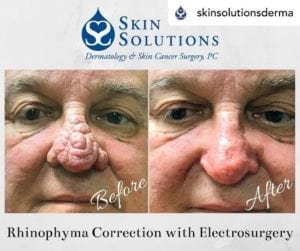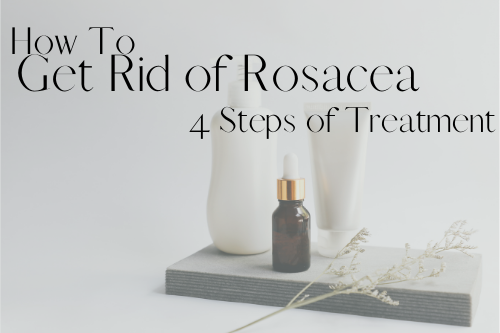How To Get Rid of Rosacea: 4 Steps of Treatment
Do you feel like at baseline your face is red? Especially on the nose and cheeks? Do you flush with heat, spicy foods, alcohol, or stress? You probably suffer from a condition called rosacea. This article will take you through causes, symptoms, triggers, and how to get rid of rosacea with 4 steps of treatment from a board certified dermatology nurse practitioner.
Click here to read how I became a dermatology nurse practitioner.
Rosacea Causes
Rosacea is when the skin becomes inflamed from many predisposing factors, most commonly named are genetics and UV exposure (sun), along with symptomatic triggers.
Without getting too medically technical with you, basically, when you have rosacea for some reason your skin is super sensitive and gets inflamed.
A relative passed this down to you more than likely. There have been instances I treated a patient and they claim no one in their family suffers from this condition.
This may be the case, but I also challenge you to consider that maybe the persons in your family are effectively treating the condition, and therefore, it is suppressed to the onlooker. Maybe you have never met the family member that suffers from the same condition you have. Lastly, maybe it was a recessive gene and only presented in just the right circumstance with you (lucky you).
Either way, you should know that rosacea is not curable.
Rosacea Symptoms and Triggers
There are 4 stages of rosacea.
The stages can present in a few different ways and be triggered by numerous events.
A trigger is defined as an event that causes an end situation. The end situation is obviously a rosacea flare.
Stage 1: Intermittent redness and flushing.
At this stage you may not even realize you have rosacea. Especially when most times it will not be present until your 30s or later.
It is common for the first signs to be flushing with spicy foods, alcohol, heat, or stress. Even if your skin is okay at baseline.
Stage 2: Persistent redness in the mid face (nose, cheeks, chin, and forehead)
A redness day in and day out regardless of triggers presents at this stage. Triggers will worsen the redness when elicited.
Stage 3: Small, pus-filled bumps and increased appearance of blood vessels (telangiectasias)
Most people seek help at this stage and often think it is acne they are coming to see me for. This stage of rosacea can mimic acne, which is the tricky part. Especially if you try to treat the acne yourself at home because rosacea skin is so sensitive.
You cannot treat rosacea-flared skin with active ingredients for acne.
Your skin will become too irritated and worsen.
It is possible to have acne and rosacea together. I find it works best to treat the rosacea and once under control, we can successfully treat acne with minimal to no irritation.
Stage 4: Bumps with skin thickening of the nose (rhinophyma)

I think the adjacent photo says it all. Once you reach stage 4 of rosacea it will take much more than a skincare regimen to help suppress flares or reverse skin thickening. At this point you will need electrosurgery or ablative lasers to reverse the progression. Anytime I am trying to convince someone they should get on top of their condition and be prophylactic, I show them this photo. This is one of my patients I performed electrosurgery on, in stage 4.
Yes, you may never get to this stage. But the reality is, you very well could.
Rosacea Treatment
1. Skincare for Rosacea
The best place to start treating rosacea is through a skincare routine.
Rosacea skin is SUPER sensitive, therefore the products should be selected carefully.
The wash I always recommend is Toleriane Hydrating Cleanser (SHOP HERE). It does not lather. Soaps that lather can be very drying and irritating, stripping your skin of its natural oils. Always make sure any cleanser you are choosing for rosacea or sensitive skin, indicates it is for sensitive skin. Preferably would be free of fragrances, dyes, and parabens as well.
Morning moisturizer with zinc is imperative for this condition. Heat and sun exposure exacerbates the redness therefore you need a mineral block every day. Zinc is also super calming (same thing in baby’s diaper rash cream) and will help to calm down the inflammatory process.
It can be difficult to find a good zinc moisturizer on your own because they are all formulated differently. Commonly, ones found in drugstores are thicker and formulated without tranparent zinc, which can leave a white hue if you do not take the time to work it into the skin. Although, some people with really dry skin enjoy this type of product!
Products on the higher end of price tend to be more elegantly formulated and contain transparent zinc which is really effortless to work into the skin and does not provide flash back from photos or cameras. Just minor things to consider and feedback I have accumulated over the years.
If you like a thicker moisturizer and are dry, I recommend Elta UV Elements (SHOP HERE).
If you prefer thinner and tend to be on the oily side, I recommend Elta UV Clear (SHOP HERE).
As your night time moisturizer I find my patients like Toleraine Ultra (SHOP HERE) or Avene A-Oxitive Cream (SHOP HERE)
2. Rosacea Medication
With the patient’s initial visit for rosacea I will place on oral antibiotics for the first month at a higher dose. Following the initial month I continue with the FDA approved daily dosage for rosacea. At this dosage the medication is only using the anti-inflammatory properties and we aren’t worried about developing resistance to the antimicrobial properties.
Along with oral antibiotics I will prescribe a skincare regimen including topical prescriptions. The problem with rosacea prescriptions is insurance doesn’t always like to cover or the co-payment is expensive so we have to do a little tweaking there to get the total cost affordable.
If you feel as you continue to flare with a gentle skincare regimen I do advise consulting with a dermatology provider as it may be time to treat with prescriptions.
3. Rosacea Diet
As discussed previously certain foods or beverages can trigger a rosacea flare. This is a case by case basis, therefore you will need to experiment with what works for you. I would hate to tell you to avoid common triggers at all costs and it does not directly apply to you. We always want to preserve quality of life and not restrict desired food or beverage groups.
Common triggers to consider: heated beverages, alcohol, capsaicin (commonly in spicy foods), cinnamon, tomatoes, citrus, and chocolate.
4. Procedures for Rosacea
Laser procedures are available to decrease redness, although I advise all my patients a laser alone will not treat rosacea effectively. Optimal results are achieved in conjunction with an avoidance of triggers, appropriate skincare routine, and prescriptions.
